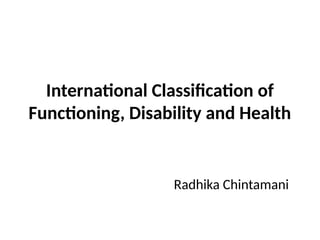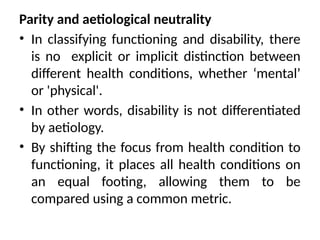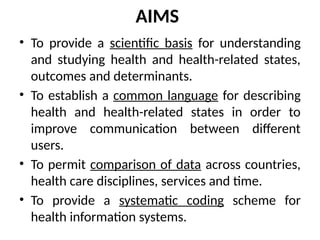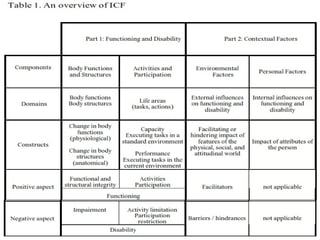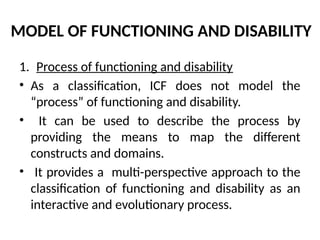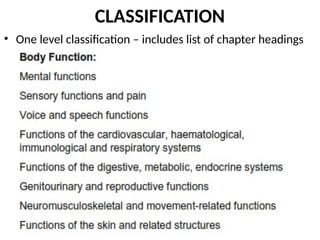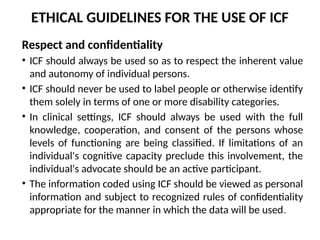ICF
- 1. International Classification of Functioning, Disability and Health Radhika Chintamani
- 2. CONTENTS • Introduction • Principles • Aims of ICF • Properties of ICF • Components of ICF • Model of functioning and disability • Applications • Classification • Ethical guidelines for using ICF
- 3. INTRODUCTION • The International Classification of Functioning, Disability and Health (ICF) is a framework for describing and organising information on functioning and disability. • It provides a standard language and a conceptual basis for the definition and measurement of health and disability. • ICF has been developed by the World Health Organization (WHO) and was endorsed by the World Health Assembly in May 2001.
- 4. • The ICF integrates the major models of disability. • It recognises the role of environmental factors in the creation of disability, as well as the relevance of associated health conditions and their effects.
- 5. PRINCIPLES Universality • A classification of functioning and disability should be applicable to all people irrespective of health condition and in all physical, social and cultural contexts. • The ICF achieves this and acknowledges that anyone can experience some disability. • It concerns everyone’s functioning and disability, and was not designed, nor should be used, to label persons with disabilities as a separate social group.
- 6. Parity and aetiological neutrality • In classifying functioning and disability, there is no explicit or implicit distinction between different health conditions, whether ‘mental’ or 'physical'. • In other words, disability is not differentiated by aetiology. • By shifting the focus from health condition to functioning, it places all health conditions on an equal footing, allowing them to be compared using a common metric.
- 7. Neutrality Domain definitions are worded in neutral language, wherever possible, so that the classification can be used to record both the positive and negative aspects of functioning and disability. Environmental Influence • The ICF includes recognition of environmental factors and its impact on people’s functioning. • These factors range from physical factors to social factors.
- 8. AIMS • To provide a scientific basis for understanding and studying health and health-related states, outcomes and determinants. • To establish a common language for describing health and health-related states in order to improve communication between different users. • To permit comparison of data across countries, health care disciplines, services and time. • To provide a systematic coding scheme for health information systems.
- 9. PROPERTIES OF ICF • Universe of ICF ICF encompasses all aspects of human health and some health-relevant components of well- being. The classification remains in the broad context of health and does not cover circumstances that are not health-related, such as those brought about by socioeconomic factors.
- 10. • Scope of ICF ICF provides a description of situations with regard to human functioning and its restrictions and serves as a framework to organize this information. It structures the information in a meaningful, interrelated and easily accessible way. ICF organizes information in two parts. Part 1 - Functioning and Disability Part 2 - Contextual Factors.
- 11. • Unit of classification ICF classifies health and health-related states. The unit of classification is categories within health and health-related domains. ICF does not classify people, but describes the situation of each person within an array of health or health-related domains. It also includes environmental and personal factors.
- 12. • Presentation of ICF ICF is presented in two versions in order to meet the needs of different users for varying levels of detail. The full version of ICF, provides classification at four levels of detail. These four levels can be aggregated into a higher-level classification system that includes all the domains. The two level system is also available as a short version of ICF.
- 13. ICF Functioning and Disability - Body Functions and Structures - Activities and Participation Contextual Factors - Environmental Factors - Personal Factors • Each component can be expressed in both positive and negative terms. • It consists of various domains and, within each domain , categories, which are the units of classification. • Health and health-related states of an individual may be recorded by selecting the appropriate category code or codes and then adding qualifiers
- 16. MODEL OF FUNCTIONING AND DISABILITY 1. Process of functioning and disability • As a classification, ICF does not model the “process” of functioning and disability. • It can be used to describe the process by providing the means to map the different constructs and domains. • It provides a multi-perspective approach to the classification of functioning and disability as an interactive and evolutionary process.
- 19. 2. Medical model • Views disability as a problem of the person, directly caused by disease, trauma or other health condition, which requires medical care provided in the form of individual treatment by professionals. • Management of the disability is aimed at cure or the individual’s adjustment and behaviour change.
- 20. 3. Social model • sees the issue mainly as a socially created problem, and basically as a matter of the full integration of individuals into society. • the management of the problem requires social action, and it is the collective responsibility of society at large to make the environmental modifications necessary for the full participation of people with disabilities. In order to capture the integration of the various perspectives of functioning, a “bio- psychosocial” approach is used.
- 21. APPLICATIONS • Statistical tool – in the collection and recording of data • Research tool – to measure outcomes, quality of life or environmental factors • Clinical tool – in needs assessment, matching treatments with specific conditions, vocational assessment, rehabilitation and outcome evaluation • Social policy tool – in social security planning, compensation systems and policy design and implementation • Educational tool – in curriculum design and to raise awareness and undertake social action.
- 22. • The ICF provides a framework for the description of human functioning, on a continuum. • It has a wide range of potential applications. • ICF can be used across broad sectors including health, disability, rehabilitation, community care, insurance, social security, employment, education, economics, social policy, legislation and environmental design and modification. • The ICF offers an international, scientific tool to study disability, in all its dimensions.
- 23. CLASSIFICATION • One level classification – includes list of chapter headings
- 27. • Two level classification - includes list of chapter headings and first branching level in the classification.
- 28. Body structure
- 31. ETHICAL GUIDELINES FOR THE USE OF ICF Respect and confidentiality • ICF should always be used so as to respect the inherent value and autonomy of individual persons. • ICF should never be used to label people or otherwise identify them solely in terms of one or more disability categories. • In clinical settings, ICF should always be used with the full knowledge, cooperation, and consent of the persons whose levels of functioning are being classified. If limitations of an individual's cognitive capacity preclude this involvement, the individual's advocate should be an active participant. • The information coded using ICF should be viewed as personal information and subject to recognized rules of confidentiality appropriate for the manner in which the data will be used.
- 32. Clinical use of ICF • Wherever possible, the clinician should explain to the individual or the individual's advocate the purpose of the use of ICF and invite questions about the appropriateness of using it to classify the person’s levels of functioning. • Wherever possible, the person whose level of functioning is being classified(or the person's advocate) should have the opportunity to participate, and in particular to challenge or affirm the appropriateness of the category being used and the assessment assigned. • Because the deficit being classified is a result of both a person's health condition and the physical and social context in which the person lives, ICF should be used holistically.
- 33. Social use of ICF information • ICF information should be used, to the greatest extent feasible, with the collaboration of individuals to enhance their choices and their control over their lives. • ICF information should be used towards the development of social policy and political change that seeks to enhance and support the participation of individuals. • ICF, and all information derived from its use, should not be employed to deny established rights or otherwise restrict legitimate entitlements to benefits for individuals or groups. • Individuals classed together under ICF may still differ in many ways. Laws and regulations that refer to ICF classifications should not assume more homogeneity than intended and should ensure that those whose levels of functioning are being classified are considered as individuals.
- 34. References: 1. World Health Organization 2001. The International Classification of Functioning, Disability and Health (ICF). Geneva: WHO. http://www.who.int/classifications/icf/en/ 2. Australian ICF-related data standards: http://meteor.aihw.gov.au/content/index.phtml/itemId/32 0319
- 35. THANK YOU

